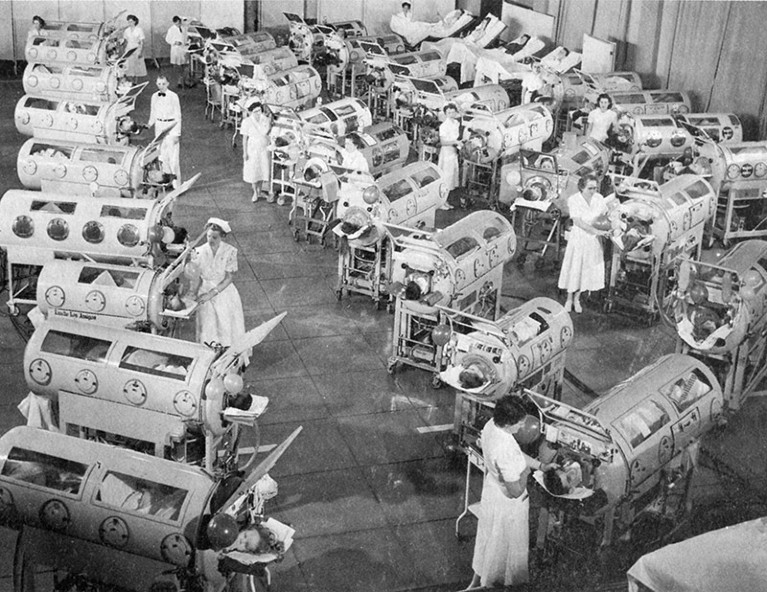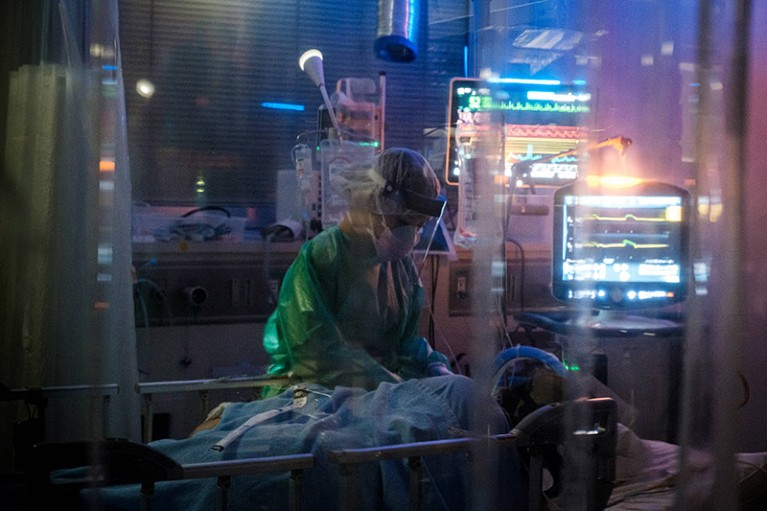
‘Iron lungs’ were used to ventilate patients in polio epidemics in the 1950s.Credit: Science History Images/Alamy
The Autumn Ghost: How the Battle Against a Polio Epidemic Revolutionized Modern Medical Care Hannah Wunsch Greystone Books (2023)
The COVID-19 pandemic has brought home the central role of intensive care units (ICUs) in saving the lives of those in critical condition in hospitals today. Yet if you asked most people where the ICU concept came from, few would know that it was an outgrowth of a polio epidemic in Denmark. In her brilliant new book, Hannah Wunsch, an anaesthesiologist and critical-care-medicine specialist at the University of Toronto, Canada, traces the origins of the modern ICU to 1952 and the Blegdam hospital in Copenhagen — something she has written about before in Nature (go.nature.com/45B6snd). There, a series of innovations arose out of dire need, including positive-pressure ventilation (the precursor to mechanical ventilators), blood-gas measurements for pH and carbon-dioxide levels and close monitoring by an interdisciplinary team of nurses, doctors (notably anaesthesiologists), pharmacists and others.
The treatment of one patient, a 12-year-old girl named Vivi Ebert who presented with bulbar paralytic poliomyelitis — in which poliovirus infects the brainstem — forms the centrepiece of Wunsch’s book. Of the first 31 people to be admitted to the Blegdam in the summer of 1952 with paralytic or respiratory polio symptoms, 87% died, 70% within three days. Thanks to interventions including manual ventilation, supervised by anaesthesiologist Bjørn Ibsen, Ebert survived another twenty years, eventually succumbing to pneumonia at the age of 32.
The outbreak that invented intensive care
In those early days it took 50 people to provide the muscle power required for round-the-clock ventilation for 6–8 people with paralytic polio. The hospital’s initial success led to more than 1,500 medical and dental students being employed as manual ventilators for patients admitted in the summer and autumn of 1952. Eventually, ‘iron lungs’ — mechanical ventilator machines — took the place of humans, and the ICU concept was built, focusing on the sickest patients, who required a breathing machine and constant monitoring. Over the next few years, the use of ICUs expanded to the treatment of people with major trauma, shock, tetanus and a variety of other acute, life-threatening conditions.
The treatment of polio, the main story of The Autumn Ghost, has rich parallels to the COVID-19 pandemic. In the 1950s, the prevailing hypothesis about the spread of polio was that the virus was inhaled into the body’s upper airways. It took decades for the gastrointestinal transmission route — oral contact with the faeces of an infected person — to become accepted. Similarly, for COVID-19, there was an initial fixation on liquid droplets on surfaces and in the air as the main means of transmission, whereas it was determined later that it was spread predominantly within tiny droplets or aerosols in the air.
Furthermore, a substantial proportion of both poliovirus and SARS-CoV-2 infections were asymptomatic. And both viruses have long-term consequences: for polio, not only potential paralysis, but also the debilitating neuromuscular syndrome that can occur decades later. Long COVID affects 10–12% of infected individuals, with a variety of enduring symptoms that can be incapacitating with potentially more longer-term effects that are yet unknown.

Mechanical ventilators have been at the fore in the COVID-19 pandemiic.Credit: Yasuyoshi Chiba/AFP via Getty
Polio taught us about the efficacy of positive-pressure ventilation for those having difficulty with breathing. With COVID-19, we learnt that ventilating patients while they were lying face down was crucial to good outcomes. For poliovirus, large, randomized trials of γ-globulin — a substance derived from bone marrow and lymph gland cells containing antibodies thought to help fight the virus — had some success in the years before a vaccine became available. For COVID-19, large observational studies were undertaken of treatment with blood plasma from those who had recovered, although a lack of randomized studies makes it hard to assess the treatment’s effectiveness.
Perhaps the most striking difference between the two viruses is how long it was before a vaccine was developed. For SARS-CoV-2, it was 10 months from sequencing the virus to producing results from large, randomized trials demonstrating high levels of vaccine efficacy. Large-scale distribution quickly followed. Poliovirus was identified as the pathogen for polio in 1908, but it wasn’t until 1955 that US virologist Jonas Salk developed the first effective vaccine to be delivered by means of an injection, followed quickly by an oral vaccine developed by US physician and microbiologist Albert Sabin in 1961.
The next generation of coronavirus vaccines: a graphical guide
Wunsch provides a detailed history of polio, the iron lung, the rise of the field of anaesthesiology, the development of the Salk and Sabin vaccines and the work at Denmark’s Statens Serum Institute, a medical laboratory in Copenhagen, in manufacturing and rolling out the Salk vaccine ten days after it was announced. But she really hits her stride when she describes those whose lives were saved. Another early patient treated by tracheostomy and hand ventilation at the Blegdam hospital was 26-year-old Rosa Abrahamsen. She was a poet, and her beautiful poems, translated into English for the book, begin several chapters.
The Autumn Ghost might have been improved with a timeline, given that it bounces back and forth at many points. Although the extraordinary progress and innovations made in Denmark were central to the development of ICUs, the contribution of parallel efforts from around the world might not have been adequately highlighted.
When I was at the University of Virginia in Charlottesville in the 1970s, I worked as a respiratory technician on the night shift, maintaining Engström ventilators (alluded to in the book as the “Rolls Royce of artificial respiration”) for patients in the ICU. I had no idea how those ventilators, or indeed ICUs, came to be. But seeing many patients ‘come back to life’ inspired me to go to medical school. Only five decades later, thanks to reading this book, have I learned the remarkable background to these profound innovations — and how the poliovirus radically transformed the future of medicine.
Competing Interests
The author declares no competing interests.








More News
A Gram-negative-selective antibiotic that spares the gut microbiome – Nature
Defying the stereotype of Black resilience
An alternative cell cycle coordinates multiciliated cell differentiation – Nature